Lower back pain usually affects people after the age of 35. In the majority of cases, the disease involves spinal deformity and its consequences. Timely visiting a doctor will speed up recovery, because symptoms and treatment of lumbar spondylolisthesis are two related concepts.
The more serious the disease, the more serious its consequences, the more difficult it is to recover your health.
Signs and symptoms of lumbar necrosis
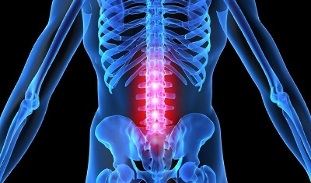
The lumbar spine is located between the sacral bone and the thoracic region and consists of five vertebrae joined together by intervertebral discs.
The development of osteonecrosis means the abrasion of the disc, performing the role of shock absorption when subjected to a load on the spine. The basis of the disc is a gel-like mass, protected by a dense fibrous ring and cartilage tissue, and the inner space is filled with a liquid pulp.
As the load on the vertebrae increases, the elasticity and flexibility of the discs and their height are lost, and small cracks form in the lumbar fiber, ultimately leading torupture and damage to the medulla.
Tissue destruction is accompanied by compression of nerve roots located on the sides of the vertebrae and causes severe pain.
Main signs of lumbar necrosis:
- back pain;
- fatigue and depression;
- weakness or excessive muscle tension;
- loss of sensation in the limbs, buttocks, or thighs;
- throbbing or aching pain and cramps in the lumbar region, often spreading down the legs;
- violates the motor function.
In the context of severe damage to the vertebra in the lumbar region, other symptoms are observed, the most common of which are dysfunction of other organs - the urinary system andreproduction, gastrointestinal tract.
Cause of what happened
Like most diseases of the musculoskeletal system, osteonecrosis can develop for a variety of reasons. Some of them are rooted in lifestyle and diet, while others develop on the basis of physiological characteristics of the body.
Usually, athletes have to treat osteoporosis of the spine, people whose backs are not only exposed to constant electrical loads but also experience periodic injuries.
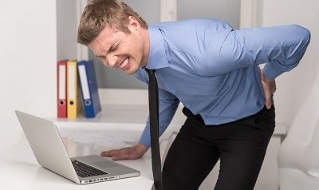
The second category of people at risk who, according to their expertise, spend a lot of time in one position - teachers, hairdressers, chefs, porters, waiters, programmersemployees, office workers and drivers.
Among other reasons for the development of pathology:
- overweight; metabolic disorders
- ;
- incorrect posture, hunched over; genetic predisposition
- ;
- injury;
- bad habit;
- lacks useful trace elements and vitamins in the diet;
- abnormal growth of the musculoskeletal system, flat feet;
- hypothermia;
- not working, static;
- is often stressful.
All of these factors can affect the elasticity of the disc, as they contribute to impaired blood circulation or the appearance of a nutrient deficiencies that enter the vertebral tissues.
The vertebrae are capable of carrying out their functions, subject to frequent tissue renewal. In the event of malnutrition of vertebral tissue, whether it is lack of blood circulation or metabolic problems, regeneration will slow down or stop completely. Thus, there is a dry and dystrophic change in the cartilage and fibrosis of the vertebra.
Degree of lumbar spine necrosis
Depending on the severity of the damage to the spine, there are four developmental levels of bone resorption, which manifest in stages as the disease progresses.
The first level
Pathological processes of the spine begin long before their first clinical manifestation. Due to the loss of moisture, the discs become less elastic. The height of the plates is still normal. The patient feels discomfort in the lower back.
The second level
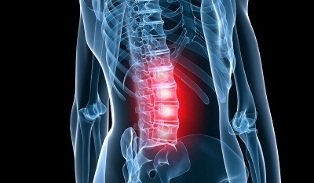
Against the background of a lack of moisture, microscopic cracks appear in annular fibrosis and tissue inflammation develops.
Hook-shaped processes of the vertebrae incrementally. The seals grow in the cartilage.
A patient complains of back pain spreading down the legs or groin. May limit mobility. Problems occurred in the work of internal organs.
The third degree
The annular fiber nucleus is broken, the disc is protruding to form a herniated mass. Nerve vessels and ends are compressed. There are manifestations of muscle spasticity, dysfunction of the pelvic organs, disturbances of the lower extremities, prolonged sciatica.
The fourth level
The most difficult, untreatable, stage of the disease. Due to the complete destruction of the discs, scars form in their place. The vertebrae approach as close as possible and gradually deform. With the development of spinal cord compression, paralysis of the lower extremities is possible.
Without prompt treatment for lumbar spondylolisthesis, destruction of the vertebrae will progress and possibly lead to disability.
Diagnosis
To recognize diseases and confirm an accurate diagnosis, neurologists use a wide range of measures - historical examination, physiological examination and instrumental research.
Shooting prehistoric
Provide the study of patient complaints:
- reasons for concern;
- position of discomfort;
- duration and intensity of discomfort;
- duration of the disease;
- can cause disease;
- frequency of exacerbations;
- factors provoking exacerbations;
- health improvement factors.
In addition, the doctor studies information about the patient's lifestyle, diet, work and rest, presence of bad habits, genetic factors and trauma.
Physiological examination
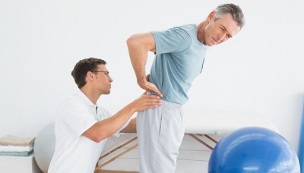
Performed to identify pathological changes and preliminary diagnosis.
During the examination, the doctor assesses the patient's mobility - gait, posture, amplitude and range of motion. The palpation method checks the state of muscles - tonicity, size, mass, presence of spasms.
Sets the level of sensitivity with a slight tingling sensation. Knocking with a hammer makes it possible to recognize irradiated areas of pain.
Hardware Research
To get complete and accurate information about the location of pathology and the extent of tissue damage, doctors use research using a variety of medical devices.
X-ray.Examination of the lumbar spine by radiography allows to determine the anatomical parameters of the vertebra and disc, the tendency to narrow the holes between the bases, the presence of the phytoplankton. development.
School imagery.The use of electromagnetic waves helps to display an image of the area under investigation on the screen for further investigation and analysis of the state of the vessels that feed the spinal tissues, nerve processes anddisc.
CT.X-ray of several sections of the spine. Images are displayed on the screen to determine the nature of changes in the vessels, membranes of the vertebrae and spinal cord, and marginal growth.
For differential diagnosis, many different types of studies are used to rule out pathologies of other body systems.
Treatment of spinal necrosis
The timing and characteristics of the treatment of lumbosacral osteonecrosis depends on the results of diagnostic measures. In the early stages of the development of the disease, conservative treatment is indicated. For more complex lesions of the spine, surgical intervention is used.
Optimal therapeutic effects are achieved through complex therapy, including topical use, physical therapy, massages, and exercises.
Medicines
For the relief of symptoms, nonsteroidal drugs for internal and external use are prescribed - pills, injections, ointments. In addition, drugs chondroprotectors, neuroprotective drugs, diuretics, vitamins, muscle relaxants are used.

Medicines allowed:
- removes soreness;
- reduces inflammation;
- relaxes muscles;
- restores damaged cartilage tissue;
- improves blood circulation;
- reduces swelling;
- increases physical activity;
- normalizes brain nutrition.
For acute pain, novocaine blockers are used to have an immediate effect.
Folk remedies
Folk remedies that support drug therapy. The main methods of traditional medicine are based on the use of plant ingredients, animal products, and chemicals.
On the basis of different ingredients, ointments and compresses, decoctions and infusions are prepared, used for internal and external use, as well as for therapeutic baths.
Physiotherapy for lumbar necrosis
Physiotherapy is a great way to restore the motor functions of the spine following bone necrosis.
The main methods of physical therapy are:
- electrotherapy- exposure to weak electrical currents to enhance blood circulation in tissues;
- magnetotherapy- the use of magnetic properties for tissue repair at the cellular level;
- laser therapy- complex activation of biological processes in vertebral tissues and nerve ends;
- shock wave therapy- improves microcirculation and metabolic processes in the affected tissues by the action of sound waves;
- therapeutic therapy- utilizes the healing properties of mineral water.
Physiotherapy procedures not only increase the effectiveness of treatment by many times, but also contribute to healing and enhancing the health of the whole body.
Lumbar osteoporosis massage
Visiting massage therapies is one of the most comfortable and effective treatments for osteonecrosis.
With massage therapy:
- removes muscle spasm;
- improves blood supply to the affected area;
- improves lymphatic flow;
- restores atrophied muscles;
- removes mobility restrictions.
Massage is indicated when the pain syndromes are eliminated.
Gymnastics
The primary task of exercise therapy for osteonecrosis is to restore function of the spine and correct it. However, you can only join classes after the exacerbation's symptoms have eliminated.
The most effective medical exercise methods are:
- is charging;
- visit the gym;
- water therapy, swimming.
You can use the bracelet for home sports. Some doctors advise their patients to practice yoga to restore flexibility of the spine.
Exercises for exacerbations of lumbar necrosis
Any exercises for osteonecrosis should be done slowly and without sudden movements.
To strengthen the muscles that support the vertebrae, appropriate exercises are done on your stomach. In this case, the arm is pulled up with a slight tension, but not in tension. Repeat 4 times.
Surgery
Surgical treatment of the spine is applied in especially difficult cases - with significant neurological disorders, as well as loss of stool control.
During the surgery, the source of the disease is removed and measures are taken to stabilize the spine. Postoperative period lasts several months.
Why is bone necrosis in the lumbar region dangerous?
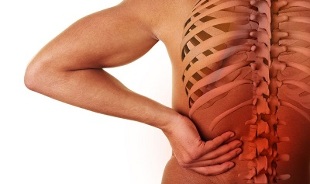
Degenerative changes that occur in lumbar necrosis contribute to the development of many life-threatening diseases. Against the background of disc herniation, bulging eyes, lumbar pain and sciatica occur.
Progressive disease can cause disc prolapse and the formation of vertebrae. In addition to the intense pain accompanying the pathology, a person's motor abilities are interrupted, to the point of complete loss. Paralysis of developed lower extremities.
Death is inevitable in cases where the lining of the spinal cord is significantly damaged.
Precautions
To avoid damaging changes to your spine, you need to practice a healthy lifestyle:
- taking part in sports - swimming, practicing;
- adhere to a well-balanced, nutritious diet;
- get rid of bad habits;
- maintain your posture;
- supports your spine during sleep with an orthopedic mattress.
In addition, should avoid hypothermia, heavy porters. Women are not advised to wear high heels as often.
You can keep your lower back healthy if you adjust your lifestyle and don't forget the importance of physical activity.







































